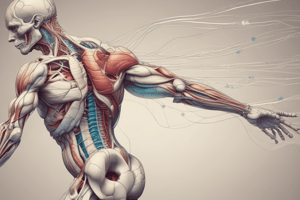Podcast
Questions and Answers
What is the primary reason for wrinkles forming on the skin?
What is the primary reason for wrinkles forming on the skin?
- Loss of facial expressions
- Improved non-verbal communication
- Decreased ability of skin to stretch or shrink (correct)
- Increased muscle movement
What is the primary function of facial expressions?
What is the primary function of facial expressions?
- To support the facial structure
- To regulate body temperature
- To aid in digestion
- To convey emotions through non-verbal communication (correct)
What is the typical progression of facial wrinkles?
What is the typical progression of facial wrinkles?
- From the brow to the chin
- From the corners of the eyes to the brow and mouth (correct)
- From the mouth to the eyes
- From the eyes to the mouth
What is the primary cause of carpal tunnel syndrome?
What is the primary cause of carpal tunnel syndrome?
What is the role of the carpal ligament in the wrist?
What is the role of the carpal ligament in the wrist?
What is the term for the passageway in the wrist where the median nerve and flexor tendons pass through?
What is the term for the passageway in the wrist where the median nerve and flexor tendons pass through?
What is a common symptom of carpal tunnel syndrome?
What is a common symptom of carpal tunnel syndrome?
What is a potential cause of carpal tunnel syndrome?
What is a potential cause of carpal tunnel syndrome?
What is the term for the muscles that enable facial expressions?
What is the term for the muscles that enable facial expressions?
What is the primary function of the facial musculature?
What is the primary function of the facial musculature?
Flashcards are hidden until you start studying
Study Notes
The Muscular System
- The muscular system creates body heat and moves the bones, food, blood, and fluids through the skeletal, digestive, circulatory, and excretory systems, respectively.
- Muscles make up 1/3 of the body's weight.
Muscle Tissue
- There are three main types of muscle tissue: skeletal, smooth, and cardiac.
- Skeletal muscle tissue is composed of long cells called muscle fibers that have a striated appearance.
- Smooth muscle tissue is found in the walls of body parts such as airways, stomach, and blood vessels.
- Cardiac muscle tissue is found only in the heart and is responsible for circulating blood throughout the body.
Skeletal Muscles
- Skeletal muscles attach to bones by tendons (connective tissue) and enable movement.
- Skeletal muscles are mostly voluntary and are controlled by the nervous system.
- A typical muscle spans a joint and tapers at each end into a fibrous tendon anchored to a bone.
Tendons
- Tendons are tough, fibrous cords of connective tissue that link skeletal muscles to bones.
- Tendons have Sharpey's fibers that pass through the bone covering (periosteum) to embed in the bone.
Smooth Muscle
- Smooth muscle is found in the walls of body parts such as airways, stomach, and blood vessels.
- Smooth muscle is involuntary and works automatically rather than under conscious control.
Cardiac Muscle
- Cardiac muscle is found only in the heart and is responsible for circulating blood throughout the body.
- Cardiac muscle has its own pacemaker for rhythmic beating.
- Cardiac muscle is made up of cells called cardiocytes.
How Skeletal Muscles Move
- Skeletal muscles move when the muscular system and the nervous system work together.
- The nervous system generates a signal that travels through a motor neuron to the neuromuscular junction.
- The signal releases a chemical message that binds to receptors on the muscle fiber, starting a chemical reaction that makes the muscle contract.
Muscle Pairs
- Muscles are grouped together in pairs on the skeleton.
- Muscles can't push, they only contract and pull the bones to which they are anchored.
- When one muscle of a pair contracts, the other relaxes.
Facial Muscles and Emotions
- The muscles of the face, head, and neck interact to move facial features such as eyebrows, eyelids, and lips.
- Facial muscles are anchored to bones, tendons, or aponeuroses (dense, sheet-like clusters of fibrous connective tissue).
- Facial expressions are an important method of non-verbal communication and can convey a wide range of emotions.
Muscular System Pathologies
- Common disorders and conditions of the muscular system include carpal tunnel syndrome, which occurs when the tendons become inflamed, causing compression of the median nerve.
Studying That Suits You
Use AI to generate personalized quizzes and flashcards to suit your learning preferences.




